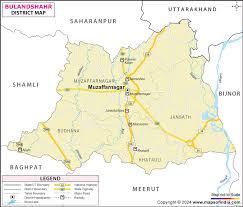Muzaffarnagar, often regarded as the gateway to western Uttar Pradesh, is a city that beautifully blends tradition, progress, and cultural heritage. It plays a significant role in the region’s agricultural economy, while also holding historical and political importance. Located approximately 125 kilometers from the national capital Delhi, the city has become a hub for trade, education, and cultural activities.
Historical Background of Muzaffarnagar
The city’s roots can be traced back to the Mughal era. It was named after Muzaffar Ali, the son of the then Mughal commander Sayyed Ali Tughlaq. Over time, Muzaffarnagar evolved from a small administrative town to a district that played a role in India’s freedom struggle. Historical landmarks still stand as reminders of its rich past.
Moreover, the British colonial influence is evident in some of the architecture found in the old city areas. Many freedom fighters from the region contributed bravely to India’s independence, making it a place of pride and remembrance.
Geography and Location

Strategically located between the rivers Ganga and Yamuna, Muzaffarnagar benefits from fertile alluvial plains. These conditions have made it one of the leading regions in sugarcane production in India. Additionally, its location on National Highway 58 enhances connectivity to major cities such as Delhi, Dehradun, and Haridwar. Because of this, the city enjoys smooth transportation access for trade and tourism alike.
Agricultural Economy and Sugar Industry
When it comes to agriculture, Muzaffarnagar is often referred to as the “Sugar Bowl of India.” The district boasts numerous sugar mills that support both the local economy and provide employment opportunities. As the demand for sugarcane-based products increases globally, Muzaffarnagar continues to grow in prominence. The fertile land also supports the cultivation of wheat, pulses, and vegetables.
Farmers in the region are increasingly adopting modern techniques. Through government support and private initiatives, agricultural productivity has improved. In turn, this has strengthened the economic framework of the district.
Cultural and Religious Diversity
One of Muzaffarnagar’s most defining features is its cultural diversity. The city is home to various communities including Hindus, Muslims, Sikhs, and Jains. Festivals such as Eid, Holi, Diwali, and Gurpurab are celebrated with equal enthusiasm. Temples, mosques, gurudwaras, and churches stand side by side, reflecting harmony in diversity.
In addition to religion, the city’s art and music scene thrives through folk dances, qawwalis, and regional literature. Local poets and writers have contributed to Hindi and Urdu literature, enhancing its cultural footprint.
Educational Institutions and Youth Development
The rise in educational institutions has transformed Muzaffarnagar into a center for learning in western Uttar Pradesh. Notable colleges and universities like Muzaffarnagar Medical College and S.D. College attract students from across the region. The focus on technical and professional education ensures that the youth are equipped for today’s competitive world.
Furthermore, skill development programs supported by the government are enabling rural youth to enter mainstream employment sectors. This transition from traditional occupations to modern skill-based careers has already started to show promising results.
Infrastructure and Urban Growth
Over the past decade, infrastructure in Muzaffarnagar has witnessed significant improvements. Roads, public transport, water supply, and electricity distribution have all seen upgrades. With increasing urbanization, the city is also developing new residential and commercial areas. Shopping complexes, healthcare centers, and entertainment venues are becoming more common.
At the same time, sustainable urban planning is being encouraged. Authorities are now focusing on eco-friendly initiatives such as waste management and solar energy projects. These developments make Muzaffarnagar a city that balances growth with environmental responsibility.
Tourism and Local Attractions
Though often overlooked as a tourist destination, Muzaffarnagar has much to offer. The Shukratal pilgrimage site, located near the Ganges, attracts spiritual seekers. The ancient Ganeshdham temple and the Bhainsi Mahadev are must-visit locations for religious and nature lovers.
For history buffs, several monuments and colonial-era buildings offer insights into the past. Local markets, rich with handicrafts and traditional food, provide a true taste of Muzaffarnagar’s spirit.
Conclusion
Muzaffarnagar stands as a shining example of how a city can maintain its heritage while embracing development. From agriculture to education, from culture to commerce, it has something for everyone. As infrastructure and industry continue to grow, so does its importance in the state of Uttar Pradesh.


